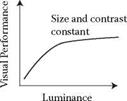The lighting intensity in a room must not be so high that there is any risk of injury. Considerable problems will arise if the light intensity is high and the light fittings are of an unsuitable design that gives rise to glare. Too low a lighting level also reduces performance considerably. Research has shown that visual performance varies according to different lighting variables (Hopkinson and Collins, 1970). The variables that affect visual performance are:
1. The luminance in the room and especially around the visual object.
2. The critical size of the visual object, i. e., the smallest element that must be distinguished in order for the whole object to be distinguished.
3. The contrast of the visual object, i. e., the relationship between the dark and the light parts of the visual object that have to be distinguished in order for the visual object itself to be distinguished.
4. The viewing time available.
Figure 7.4 summarises the way in which visual performance varies with the different variables.
A suitable illumination level in a control room is about 1000 lux or higher at night-time to keep the operators’ arousal at a high level. If VDUs are in use, however, the illumination level should be restricted to 300 lux. The luminance distribution in the room has to be comfortable. This is determined by the reflection factors on the surrounding surfaces. The reflection factors are the proportion of light reflected or retransmitted from a surface, varying from 0.0 for totally black to 1.0 for total light reflection. The reflection factors of the room surfaces should be about 0.2 to 0.4 on floors, 0.4 to 0.6 on walls, and about 0.4 to 0.8 on the ceiling, with the lower values being suitable if there is risk of reflections occurring in VDU screens.
![]() Standard Units, Symbols, and Defining Equations
Standard Units, Symbols, and Defining Equations
|
TABLE 7.2 Definitions and Conversion Factors for Lighting Units
|
|
Candelas per sq metre (cd/m2) |
і |
10 000 |
|
Stilb (cd/m2) |
lxlO2 |
1 |
|
footlambert (fl) |
0.2919 |
2919 |
|
footcandle (lm/ft2) |
0.0929 |
|
Notes: 1 footcandle (fc) = 10.764 lux; 1 lux = 0.0929 fc. |
|
||
|


 |
FIGURE 7.4 Variables affecting visual ability. (From research by Weston, 1962. With permission.)
The lighting levels on the working surfaces and control panel should be greater than those in the room in general. These surfaces should also have a rather higher reflection factor than the room in general in order for the luminance to be higher on these surfaces; that is, they should stand out as being brighter than the overall room luminance. However, it is important for panels and worktables not to be shiny, otherwise reflections would result. Figure 7.5 gives suggestions for acceptable reflection factors in places where VDUs are used.
The design of the light fittings in the control room is very important. In most types of control rooms, particularly those with VDUs, it is very important that the
60
g
СЯ
40
5-і
W
bO
c
"3
20
PS
0
FIGURE 7.6 Reading errors due to luminance.
lights do not cause reflections in the object being viewed. It may often be best to use reflective (for example, ‘Paracube’) shading under fluorescent strip lights, as these direct the light vertically downwards and give a relatively dark surface when seen from the side.




